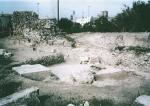Summary (English)
In 2005, a part of the western city walls of Salona was excavated. During the time of the Emperor Marcus Aurelius, under the reception of the first barbarian raids behind the borders of the Roman Empire in 170, the western and eastern suburbs of Salona were protected by a new ring of city walls. This construction project also includes the Amphitheatre, which was located on the outskirts of the city which was built-in in the unique fortification system of the western part of the city (Urbs occidentalis).
The Amphitheatre had three levels, of which the lower two had openings with arches – decorated with semi-columns with Doric or Ionic capitals – and the third level with smaller quadrangular openings, also separated with semi-columns. Three inner corridors were located at the substructure system, which carried the auditorium (cavea) and the gallery above. The Amphitheatre, measuring 125 × 102 m (arena 60 × 40 m), could accommodate 16,000 – 17,000 spectators, according to Dyggve’s estimate. From the inner corridor that surrounds the arena (via venatorum) there was an access to two small gladiator sanctuaries dedicated to the goddess Nemesis. Later, in the early Christian era, the shrines were transformed into the oratoria of the Salona’s martyrs who died in the arena during Diocletian’s persecutions.
New excavations have revealed the connection between the western city walls and the Amphitheatre. The line of city walls extends inside the Amphitheatre itself; its outer ring is dismantled, and the city walls are closed below square pylons at the ends of individual radial walls of the substructure of the theatre. The northern city walls also lie within the northern line of substructure of the theatre, creating a closed bastion at the western corner of the city with the western walls of the Amphitheatre.
A trench was opened where the inner side of the western city walls was connected to the Amphitheatre (long approx. 13 m). Numerous pottery fragments were found during the excavations (Jasna Jeličić-Radonić 2006, Hrvatski arheološki godišnjak 2/2005, 391–393).
- Jasna Jeličić-Radonić
Director
- Jasna Jeličić-Radonić
Team
Research Body
- Arheološki muzej u Splitu
- Konzervatorski odjel u Splitu
Funding Body
- Agencija Eko-Kaštelanski zaljev






![Download [PDF]](/excavation/skins/fasti/images/results/download_sml.png)
